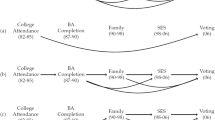Abstract
The effects of polls on public opinion and voting behavior have begun to attract considerable attention. However, aside from experimental studies and research on exit polls, the impact of preelection polls has not received adequate analysis. This paper investigates whether exposure to polls released during the campaign influences voter choices and how the electoral context of referendum versus candidate elections makes a difference in terms of polling effects. These questions were addressed in a cross-election comparison of the 1980 presidential campaign and a 1986 state referendum on the right-to-life issue. Basically, I found significant effects during the referendum, but weak effects in the presidential general election.
Similar content being viewed by others
References
Asher, Herbert (1987).Public Opinion Polling. Washington, DC: Congressional Quarterly Press.
Bartels, Larry (1988).Presidential Primaries and the Dynamics of Public Choice. Princeton NJ: Princeton University Press.
Brady, Henry, and Richard Johnston (1987). What's the primary message. In Gary Orren and Nelson Polsby (eds.),Media and Momentum. Chatham, NJ: Chatham House Publishers.
Busch, Ronald, and Joel Lieske (1985). Does time of voting affect exit poll results.Public Opinion Quarterly 49(Spring): 94–104.
Ceci, Stephen, and Edward Kain (1982). Jumping on the bandwagon with the underdog: The impact of attitude polls on polling behavior.Public Opinion Quarterly 46(Summer): 228–242.
Cronin, Thomas (1989).Direct Democracy: The Politics of Initiative, Referendum, and Recall. Cambridge, MA: Harvard University Press.
Dahl, Robert (1956).A Preface to Democratic Theory. Chicago: University of Chicago Press.
Dubois, Philip (1983). Election night projections and voter turnout in the West: A note on the hazards of aggregate data analysis.American Politics Quarterly 11(July): 349–364.
Epstein, Laurily, and Gerald Strom (1981). Election night projections and West Coast turnout.American Politics Quarterly 9(October): 479–491.
Epstein, Laurily, and Gerald Strom (1984). Survey research and election night projections.Public Opinion 7(February/March): 48–50.
Field, Mervin (1981). Presidential election polling.Public Opinion 4(5)(October/November): 16–19, 56–58.
Fuchs, Douglas (1966). Election-day radio-television and western voting.Public Opinion Quarterly 30(Summer): 226–236.
Ginsberg, Benjamin (1986).The Captive Public. New York: Basic Books.
Graber, Doris (1984).Mass Media and American Democracy, 2nd ed. Washington, DC: Congressional Quarterly Press.
Jackson, John (1983). Election night reporting and voter turnout.American Journal of Political Science 27(November): 615–635.
Kahneman, Daniel, Paul Slovic, and Amos Tversky (1982).Judgment Under Uncertainty: Heuristics and Biases. New York: Cambridge University Press.
Levy, Mark (1983). The methodology and performance of election day polls.Public Opinion Quarterly 47(Spring): 54–67.
McKelvey, Richard, and Peter Ordeshook (1986). Information, electoral equilibria, and the Democratic ideal.Journal of Politics 48(November): 909–937.
McKelvey, Richard, and Peter Ordeshook (1985). Sequential elections with limited information.American Journal of Political Science 29(August): 480–512.
Mendelsohn, Harold (1966). Election-day broadcasts and terminal voting decisions.Public Opinion Quarterly 30(Summer): 212–225.
Oldendick, Robert, Susan Sorenson, Alfred Tuchfarber, and George Bishop (1985). Last birthday respondent selection in telephone surveys. Paper presented at the annual conference of the Midwest Association for Public Opinion Research. Chicago, Illinois. November 23.
Page, Benjamin, and Robert Shapiro (1983). Effects of public opinion on policy.American Political Science Review 77(March): 175–190.
Sabato, Larry (1981).The Rise of Political Consultants. New York: Basic Books.
Schattschneider, E. E. (1960).The Semi-Sovereign People. Hinsdale, IL: Dryden Press.
Simon, Herbert (1979).Models of Thought. New Haven, CT: Yale University Press.
Tuchman, Sam, and Thomas Coffin (1971). The influence of election night television broadcasts in a close election.Public Opinion Quarterly 35: 315–326.
Wolfinger, Raymond, and Peter Linquiti (1981). Tuning in and turning out.Public Opinion 4(February/March): 56–60.
Author information
Authors and Affiliations
Rights and permissions
About this article
Cite this article
West, D.M. Polling effects in election campaigns. Polit Behav 13, 151–163 (1991). https://doi.org/10.1007/BF00992294
Issue Date:
DOI: https://doi.org/10.1007/BF00992294




